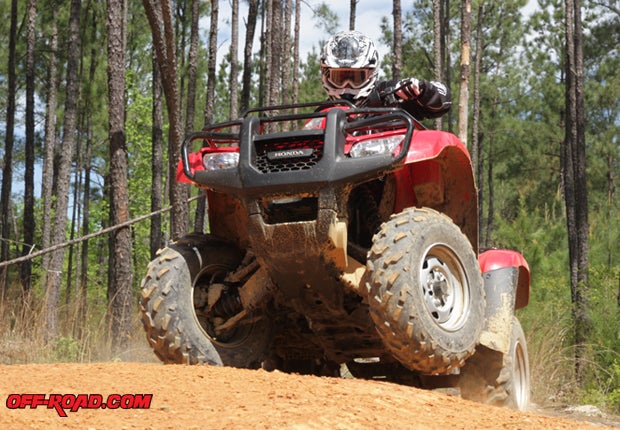
To introduce its new 2012 ForeTrax Foreman, Honda invited us to a press launch in South Carolina to check out this updated ATV. It was a two-stage product introduction that included a visit to the Honda of South Carolina facility, where the Foreman is made, and a riding day aboard the new 500-class machine at Carolina Adventure World.
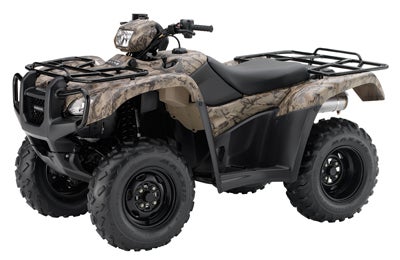 The Foreman has been in the Honda family almost 25 years and began as a 350cc model. Honda said the 2012 FourTrax 500 4x4 is the fifth generation of the model and it is essentially all new. The new Foreman will be available in May with an all-new look and with more features than ever, yet it maintains its reputation as a hard-working and dependable ATV.
The Foreman has been in the Honda family almost 25 years and began as a 350cc model. Honda said the 2012 FourTrax 500 4x4 is the fifth generation of the model and it is essentially all new. The new Foreman will be available in May with an all-new look and with more features than ever, yet it maintains its reputation as a hard-working and dependable ATV.
Honda’s engineering team focused on three key segments with this redesign: appearance, power and comfort. The manufacturer will still offer four different versions of the Foreman, including two foot-shift models and two Electronic Shift versions. The 2012 Foreman is also important to Honda because it marks the first time a machine was designed (from concept to production) and built in the US. We were there when it came off the line at Honda’s Timmonsville, South Carolina, production facility.

2012 Foreman Overview
- New body styling with a more aggressive look featuring large oversized fenders for improved mud and splash protection.
- New multi-function LCD digital meter
- Liquid-cooled, four-stroke engine
- Higher compression ratio
- New fuel injection system features a 36mm throttle body
- All-new rear suspension system with a new steel swingarm and a single rear shock (6.9 inches of travel)
- Larger dual front hydraulic disc brakes
- New tires
2012 Pricing
Foreman 4x4 foot - $6,899
Foreman ES 4x4 -$7,099
Foreman 4x4 foot with EPS – $7,499
Foreman ES 4x4 with EPS -7,699
 ENGINE
ENGINE
An all-new single-cylinder OHV four-stroke engine with a displacement of 475cc powers the Foreman. However, this engine is liquid cooled and features a 10 percent higher compression ratio (from 8:5.1 to 9:5.1), which improved its overall power. Honda reported a 6 percent gain in torque and 10 percent increase in horsepower. American Honda’s Kevin Aschenbach stated that riders should notice more low-end snap and, in general, a better hit off the bottom. But he said this Foreman would feel more responsive for other reasons, too.
With benefits like lower operating temperatures and added durability, Aschenbach stated that liquid cooling offers an ideal fit for the Foreman. “Going to liquid cooling there’s naturally going to be some hesitance of ‘well, now I have a radiator and antifreeze to worry about,’ but the people will understand with Honda technology it is tried-and-true and proven it’s not a guessing game and is something we’ve spent a lot of time perfecting,” he explained.
In addition to the new cooling, the Foreman now features electronic fuel injection with a 36mm throttle body. Along with improved fuel efficiency, Aschenbach said the Foreman’s EFI system, “Offers better cold-weather starting, high-altitude performance and you’re not going to worry about jetting from low to high altitudes.”
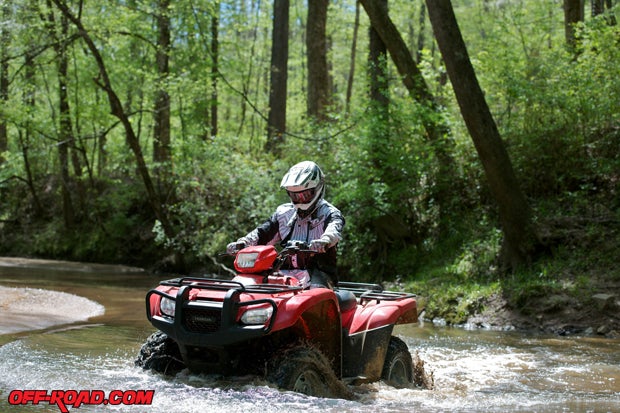
The redesigned Foreman produced a quicker and more noticeable low-end hit. However, we burned through first and second gear rather quickly! Third gear seemed to be the ideal spot on the 4x4, as we could lug it in the slow-speed areas and rev it in other areas of the test trail. This Honda isn’t as swift as some modern-day sport-utility quads we’ve ridden, but we were pleased with fourth and fifth gear.
SUSPENSION/HANDLING
The most noticeable change was made to the Foreman’s rear suspension. It went from a dual-shock configuration to a single-shock and steel swingarm design. The single shock is higher quality and offers five-way preload adjustability, heavier spring rates and almost 7 inches of travel.
“The valving for the initial ride plushness is still comfortable and more plush than previous models,” Aschenbach said. “It’s such a hard-working machine that people use it so much, you want to make sure that somebody who is going to ride it all day, everyday on the farm, ranch and trails is going to be comfortable.”
.jpg)
And with working and riding, Honda engineers had to offer a rear shock that offered a plusher ride than previous generations yet also stayed true to the work ethic of the machine, Aschenbach explained.
An all-new steel swingarm is three inches wider than the prior model and features a brace. Aschenbach said the brace was added to balance the swingarm rigidity with allowing the machine to flex a little bit so it could track straight and true – keep its line straight and remain solid. And the rear axle is enclosed in an axle housing for added durability. The Foreman’s new front shocks are adjustable for preload and offer 6.7 inches of travel. They too were designed to offer an improved ride comfort (added plushness) especially at the initial part of the stroke.
The entire suspension package, offering five-way adjustable preload settings, is important enough, but it was also more comfortable. Sure, it was more utility-orientated than sporty, but it could still smooth out the harshness of a trail. The shocks are important for those who plan to use the Foreman for work. Its 199-pound combined rack capacity (that’s 66 front and 133 rear) will be assisted by Honda’s preload adjustable suspension and will help people use the Foreman more effectively. In rugged, rocky terrain or when riding sporty, the suspension will be fully used as will the 7.6 inches of ground clearance.
Get the Flash Player to see this player.
“One of the things Honda has always stood by is that our rating is conservative,” Aschenbach explained. “We may have a number like 66/133 and that’s something we feel is the safe limit for still maintaining all our handling and stability standards. It’s possible to up the rack cargo capacities to what oftentimes is maybe an unrealistic number — and I think some of the manufacturers unfortunately do to lure people on the sales floor — and creates something that doesn’t meet our internal Honda engineering standards.”
Honda addressed another area for both work and play by beefing up the Foreman’s front brakes. Disc brakes up front increased in size from 180mm to 196mm. “Along with the increased size, we’re increasing the brake capacities. It will stop with a full load of towing and a full load of rack capacity and will not have a soft brake feel,” Aschenbach stated. However, the rear drum configuration remains because Honda said its stopping power has proven to be very effective.
The Honda wears new 25-inch Maxxis tires (25 x 8 -12 front 25 x 10-12 rear) that seemed happy to supply traction on fire roads and on the trail. Aschenbach called the tire an exclusive design made for Honda that features a balance between the right comfort, stiffer sidewall for work capabilities and the right traction for overall durability. We ran the tire in creeks, on hard pack, rutted turns and in aggressive power slides and were pleased with it.
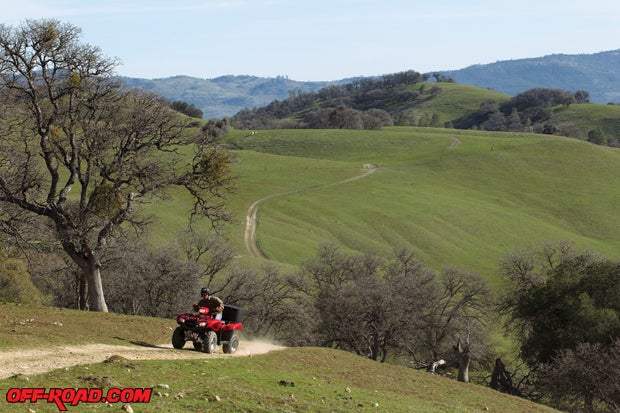
Electronic Power Steering improves the handling on the Honda. Although Honda ATVs have never been difficult or overly heavy to steer, EPS lightens the task, especially in rough situations, long rides or in working situations. This is especially true for those who use their machine for one-hand, slow-speed working situations (wand sprayers for example). However, it was much appreciated while playing in the rocky climbs during our test session. The Foreman is very predictable and mostly stable even when pushed to its limits. We never felt out of control on the Honda nor did we have to overcompensate to ride it aggressively. Sometimes, we could entice the outer rear wheel to lift off the ground during hard cornering, but the quad remained controllable.
ERGONOMICS/APPEARANCE
Honda’s engineering team put a lot of focus on the Foreman’s ergonomics. For 2012, the Honda widened and raised the Foreman’s bars to produce a more comfortable feel and riding impression. Even more noticeable than the bars is the 4x4’s new face and fenders.
“Appearance went from a sport-utility look to a more aggressive look with new bodywork, higher stance and wider stance,” said Aschenbach. “It definitely gives the machine a lot bigger, tougher look.”
He also mentioned the Foreman has more wheel clearance, improved mud and splash protection and is larger than either the Rubicon or the Rancher ATVs. A softer seat material was meant to add comfort yet not sacrifice durability and also improved the ride triangle. Along with the full floorboards, a rider feels both comfortable and protected.
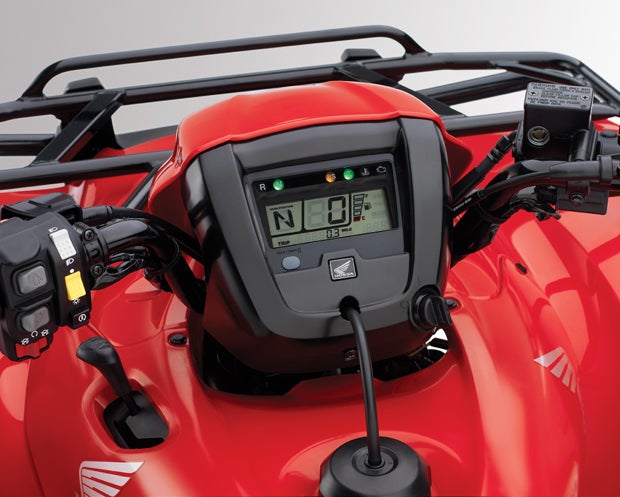
The new multi-function LCD digital meter is waterproof and rugged. It features large readouts for fuel gauge, gear position, speedometer, odometer, tripmeter, hourmeter and oil change reminder. LED lights for reverse, neutral, oil temperature and front differential indicator are also included.
A cable-actuated TraxLok 2WD/4WD manual lever (a design borrowed from the Rancher) replaced the previous Foreman’s elctro-mechanical 4WD switch. The system is very easy to use and gets the job done. It also retained the somewhat archaic reverse mechanism. Again, it’s effective and easy to use (once you understand it), but it’s an old school setup.
We’re thankful that Honda is one of the few makers to offer a foot-shift transmission (also available on the Foreman) as well as its ESP design. Honda reported that both ESP and foot shifting are popular among its buyers for different reasons. We didn’t get to ride the new machine with a foot-shift transmission, but we did ride an ESP model. The electronic thumb shifting is good for most situations, but we’d prefer to shift with our foot when riding sporty.
Other positive features on the Foreman include twin storage areas (front left fender and rear cargo box), front and rear brake levers, 12-volt, waterproof accessory socket provides 12-volt, 850-pound tow rating, triple headlights and headlight pod for directional lighting, internal brake scraper and shaft drive.
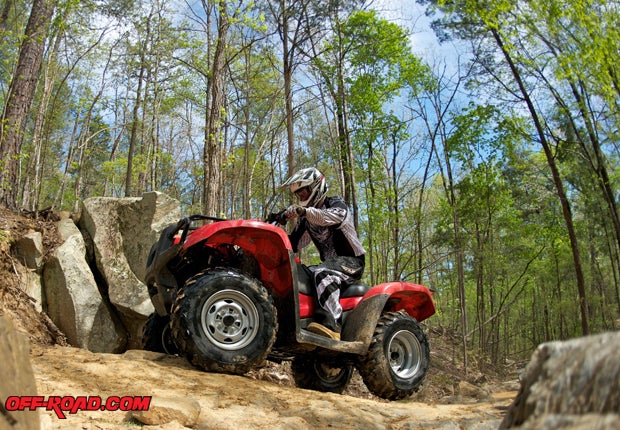
FINAL THOUGHTS
Overall, the 2012 Honda Foreman offers a more comfortable package and improved power. It handles a little differently too that previous Foreman ATVs, but it still remains predictable. Aschenbach said all manufacturers must weight cost with features and benefits when redesigning products.
“It’s something that we still want to keep at an attractive price point for all the buyers and not price someone out of that unit because it’s such a good-selling model,” he said. “You want to balance the technology with the proven [items]. The brakes and reverse system have always worked well. Adding EFI, EPS and liquid cooling adds cost, so you have to pick and choose what you can and can’t update.”
According to Aschenbach, Honda’s research has shown that a utility model from 5 to 10 years ago was meant strictly for utility, whereas now that utility and that recreation are blending together. “Our aim was to maintain more work capability and still go along the advancements and the additional buyer who is going to use this for hard work on the farm, but yet is still going [want it] to perform while on trails,” he said.
We think the 2012 Foreman is a step in the right direction and would even call it the best Foreman to date. It’s a familiar-but-improved package that offers more comfort and power and should appease both customers and dealers alike.
For more information, visit http://powersports.honda.com/offroad.aspx.


 Your Privacy Choices
Your Privacy Choices